Definition. A rational
number is a real number which can be written as ![]() , where a and b are integers and
, where a and b are integers and
![]() . A real number which is not
rational is irrational.
. A real number which is not
rational is irrational.
Example. Prove that if p is prime, then ![]() is irrational.
is irrational.
To prove this, suppose to the contrary that ![]() is rational. Write
is rational. Write ![]() , where a and b are
integers and
, where a and b are
integers and ![]() . I may assume that
. I may assume that ![]() --- if not, divide out any common factors.
--- if not, divide out any common factors.
Now
![]()
Since ![]() and p is prime,
and p is prime, ![]() . Write
. Write ![]() . Then
. Then
![]()
Now ![]() , so
, so ![]() . Thus, p is a common factor of a and b
contradicting my assumption that
. Thus, p is a common factor of a and b
contradicting my assumption that ![]() .
.
It follows that ![]() is
irrational.
is
irrational.![]()
More generally, suppose ![]() , ...,
, ..., ![]() are integers and
are integers and
![]()
Then the roots are either integers or irrational.
If b is an integer such that ![]() , and a is a positive integer, then for
some
, and a is a positive integer, then for
some ![]() I can write a uniquely in the form
I can write a uniquely in the form
![]()
This is called the base b expansion of a.
Note that
![]()
The notation is ![]() , with the subscript b denoting the base. We omit the
subscript for number given in base-10.
, with the subscript b denoting the base. We omit the
subscript for number given in base-10.
Thus, the value of a is obtained by plugging ![]() into the polynomial
into the polynomial
![]()
The standard way to do this by hand is to use synthetic division.
Example. Convert ![]() to base-10. Use synthetic
division:
to base-10. Use synthetic
division:
![]()
Thus, ![]() .
.![]()
To convert from base-10 to base-b, we just have to undo the process above. I divide the number by the base, noting the quotient and the remainder. Then I divide the quotient by the base, and so on. The successive remainders give the base-b digits (backwards).
Example. Convert 3915 to base-8. Divide 3915 by 8. The quotient is 489 and the remainder is 3:
![]()
Divide 489 by 8. The quotient is 61 and the remainder is 1:
![]()
Divide 61 by 8. The quotient is 7 and the remainder is 5:
![]()
Since 7 is less than 8, I can stop here. The answer is ![]() .
.![]()
Note that if you want to convert between base-b and base-c, you could just do
![]()
What about a positive number which is not an integer? I can write any positive real number as a sum of a positive integer and a real number between 0 and 1. I already know how to convert positive integers to base-b.
So suppose b is an integer such that ![]() , and a is a real number between 0 and 1
(inclusive). Then a can be written uniquely in the form
, and a is a real number between 0 and 1
(inclusive). Then a can be written uniquely in the form
![]()
Rather than proving this fact, I'll merely recall the standard
algorithm for computing such an expansion: Subtract from a as many
![]() 's as possible, subtract as many
's as possible, subtract as many
![]() 's from
what's left, and so on.
's from
what's left, and so on.
Here is a recursive procedure which generates base b expansions:
![]()
![]()
To see why this corresponds to the standard algorithm, note that at
the first stage I'm trying to find ![]() such that
such that
![]()
These equations are equivalent to
![]()
Equivalently,
![]()
That is, ![]() , and a corresponds to
, and a corresponds to ![]() .
.
It's convenient to arrange the computations in a table, as shown below.
Example. Find 0.4 in base 7.
I fill in the rows from left to right. Starting with an x, multiply
by ![]() to fill in the third column. Take
the greatest integer of the result to fill in the a-column of the
next row. Subtract the a-value from the last
to fill in the third column. Take
the greatest integer of the result to fill in the a-column of the
next row. Subtract the a-value from the last ![]() -value to get the next x, and continue. You
can check that this is the algorithm described above.
-value to get the next x, and continue. You
can check that this is the algorithm described above.
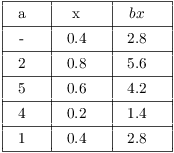
The expansion clearly repeats after this, since I'm getting 0.4 for x again. Thus,
![]()
Definition. The decimal expansion ![]() terminates
if there is a number
terminates
if there is a number ![]() such that
such that ![]() for
for ![]() .
.
In this case,
![]()
Hence, x is rational.
In fact, rational numbers in ![]() with terminating decimal are exactly the
rational numbers of the form
with terminating decimal are exactly the
rational numbers of the form ![]() for
for ![]() and
and ![]() .
.
Suppose a rational number has the form ![]() for
for ![]() and
and ![]() . To see this, multiply the top
and bottom by a power of 2 or a power of 5 to get a power of 10 on
the bottom. Then
. To see this, multiply the top
and bottom by a power of 2 or a power of 5 to get a power of 10 on
the bottom. Then ![]() , which is represented by a terminating decimal with
q being the "decimal part". For example,
, which is represented by a terminating decimal with
q being the "decimal part". For example,
![]()
Going the other way, note that
![]()
For instance,
![]()
Thus, a terminating decimal has the form ![]() for
for ![]() and
and ![]() .
.
A decimal expansion ![]() is
periodic with period k if there is a positive
integer N such that
is
periodic with period k if there is a positive
integer N such that ![]() for all
for all
![]() .
.
Proposition. A periodic decimal expansion represents a rational number.
Proof. (Sketch) First consider the simplest case of a periodic decimal
![]()
This is a geometric series with first term ![]() and ratio
and ratio ![]() .
.
a and r are both rational The sum of such a geometric series is ![]() , which is also a rational number.
, which is also a rational number.
Suppose there is a pre-period --- an initial segment before the repeating part:
![]()
This is a sum of two rational numbers: The rational number
corresponding to the terminating decimal ![]() and the rational number
corresponding to the periodic part
and the rational number
corresponding to the periodic part ![]() , shifted by j places. Explicitly, if
, shifted by j places. Explicitly, if ![]() and
and ![]() , then
, then
![]()
Once again, this is rational.![]()
Example. Express ![]() as a rational number in lowest
terms.
as a rational number in lowest
terms.
Since the number has period 3, I multiply both sides by ![]() :
:
![]()
Next, subtract the first equation from the second:
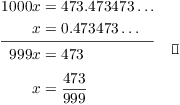
Example. Express ![]() as a rational number in lowest terms.
as a rational number in lowest terms.
Since the number has period 3, I multiply both sides by ![]() :
:
![]()
Next, subtract the first equation from the second:
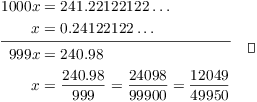
Example. Express ![]() as a
base-10 rational number in lowest terms.
as a
base-10 rational number in lowest terms.
Since the number has period 3, I multiply both sides by ![]() :
:
![]()
Next, subtract the first equation from the second, being careful about the bases: I have base-10 on the left, but base-8on the right.
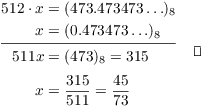
In the next two problems, I'll use the formula for the sum of a geometric series:
![]()
Example. Suppose b is an integer and ![]() . Express the following as a rational
function of b:
. Express the following as a rational
function of b:
![]()
Using the formula for the sum of a geometric series, I have
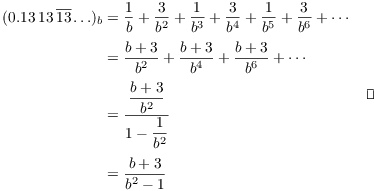
Example. Suppose b is an integer and ![]() . Express the following as a rational
function of b:
. Express the following as a rational
function of b:
![]()
Using the formula for the sum of a geometric series, I have
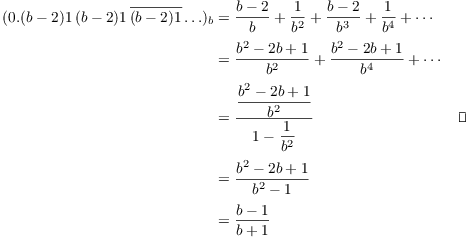
Proposition. A rational number can be represented by either a terminating decimal, or a periodic decimal.
Proof. (Sketch) Suppose ![]() is a rational number in lowest
terms, so
is a rational number in lowest
terms, so ![]() , and
, and ![]() .
.
I've already shown that ![]() ca be represented by a terminating
decimal if and only if
ca be represented by a terminating
decimal if and only if ![]() for some
for some ![]() .
.
I'll consider the case where ![]() , so q is not divisible by 2 or by
5. By Euler's theorem,
, so q is not divisible by 2 or by
5. By Euler's theorem,
![]()
Since some positive power of 10 is equal to 1 mod q, there must be a
smallest positive power n such that ![]() . (This is called the order of 10 mod q.) Thus,
. (This is called the order of 10 mod q.) Thus,
![]()
I have
![]()
On the other hand, I have the decimal expansion
![]()
Here x represents the remainder of the decimal expansion, so
![]()
Note that
![]()
Hence, ![]() .
.
So multiplying the equation for ![]() by
by ![]() , I get
, I get
![]()
Comparing the two equations for ![]() , I have
, I have
![]()
I have an integer on either side, namely ![]() and
and ![]() .
I also have on either side numbers in the range
.
I also have on either side numbers in the range ![]() , namely
, namely ![]() and
and ![]() . This is only possible if
. This is only possible if ![]() . This means that at the
. This means that at the ![]() place the decimal being
constructed is the decimal for the original
place the decimal being
constructed is the decimal for the original ![]() . Hence, the decimal must repeat
after that point.
. Hence, the decimal must repeat
after that point.
I'll omit the case where ![]() , where
, where ![]() . In this case, the decimal has a
pre-preriod before it begins to repeat.
. In this case, the decimal has a
pre-preriod before it begins to repeat.![]()
For example, consider the rational fraction ![]() . I have
. I have ![]() , and checking powers I find that
, and checking powers I find that
![]() , and this is the
smallest positive power of 10 equal to 1 mod 21. Thus, I expect the
decimal to have period 6. In fact,
, and this is the
smallest positive power of 10 equal to 1 mod 21. Thus, I expect the
decimal to have period 6. In fact,
![]()
Copyright 2019 by Bruce Ikenaga